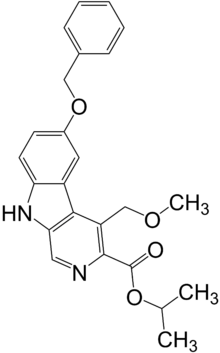아베카닐
Abecarnil | |
| 임상자료 | |
|---|---|
| ATC 코드 |
|
| 약동학 데이터 | |
| 제거 반감기 | 3.4시간(IV), 7시간(도덕) |
| 식별자 | |
| |
| CAS 번호 | |
| 펍켐 CID | |
| 켐스파이더 | |
| 유니 | |
| 케그 | |
| 켐벨 | |
| CompTox 대시보드 (EPA) | |
| 화학 및 물리적 데이터 | |
| 공식 | C24H24N2O4 |
| 어금질량 | 404.466 g·190−1 |
| 3D 모델(JSmol) | |
| |
| |
| (iii) | |
아베카닐(ZK-112,119)은 β-카르볼린 계열의 항불안제다.비벤조디아제핀으로 알려진 비교적 최근에 개발된 의약품의 종류 중 하나로, 오래된 벤조디아제핀 그룹과 효과는 비슷하지만 화학 구조는 상당히 다르다.GABAA 수용체 벤조디아제핀 현장에서 선별적으로 작용하는 부분작용제다.[1]null
아베카닐은 원래 항불안제로 개발되었지만, 아직까지 상업적으로 인간에게 쓰일 수 있도록 개발되지 않고 있으며, 그 대신 지금까지 주로 다른 진정제 및 항불안제의 개발에 대한 연구에 이용되고 있다.그 행동에 대한 조사가 계속되고 있고 그것은 불안의 치료와 [2]벤조디아제핀과[3] 알코올[4] 중독의 치료의 덜 중독적인 대체 약물로 개발될 것으로 보인다.아베카닐은 선택성 완전작용제인 벤조디아제핀 작용제에 비해 내성과 금단 문제가 적을 수도 있다.[5]null
아베카닐은 비교적 진정제나 근육 이완제 성질이 덜하고 알코올의 효과를 크게 일으키지 않는 비교적 아형 선택성 의약품이다.[6][7][8]null
갑작스런 치료 중단 후 가벼운 금단증상만 나타나는 [9]등 아베카닐의 남용 잠재력은 벤조디아제핀보다 적은 것으로 생각된다.[10]null
참고 항목
참조
- ^ Ozawa, M; Nakada, Y; Sugimachi, K; Yabuuchi, F; Akai, T; Mizuta, E; Kuno, S; Yamaguchi, M (Mar 1994). "Pharmacological characterization of the novel anxiolytic beta-carboline abecarnil in rodents and primates". Japanese Journal of Pharmacology. 64 (3): 179–87. doi:10.1254/jjp.64.179. PMID 7912751.
- ^ Aufdembrinke B (1998). "Abecarnil, a new beta-carboline, in the treatment of anxiety disorders". British Journal of Psychiatry. 34 (34): 55–63. doi:10.1192/S0007125000293537. PMID 9829018.
- ^ Pinna G, Galici R, Schneider HH, Stephens DN, Turski L (Mar 1997). "Alprazolam dependence prevented by substituting with the beta-carboline abecarnil". Proceedings of the National Academy of Sciences of the United States of America. 94 (6): 2719–23. Bibcode:1997PNAS...94.2719P. doi:10.1073/pnas.94.6.2719. PMC 20156. PMID 9122263.
- ^ Jung ME, Wallis CJ, Gatch MB, Lal H (Jun 2000). "Abecarnil and alprazolam reverse anxiety-like behaviors induced by ethanol withdrawal". Alcohol. 21 (2): 161–8. doi:10.1016/S0741-8329(00)00079-3. PMID 10963939.
- ^ Löscher W, Hönack D (April 1992). "Withdrawal precipitation by benzodiazepine receptor antagonists in dogs chronically treated with diazepam or the novel anxiolytic and anticonvulsant beta-carboline abecarnil". Naunyn Schmiedebergs Arch. Pharmacol. 345 (4): 452–60. doi:10.1007/BF00176624. PMID 1352384. S2CID 20486955.
- ^ Krause W, Schutt B, Duka T (May 1990). "Pharmacokinetics and acute toleration of the beta-carboline derivative abecarnil in man". Arzneimittelforschung. 40 (5): 529–32. PMID 1974428.
- ^ Duka T, Schutt B, Krause W, Dorow R, McDonald S, Fichte K (Apr 1993). "Human studies on abecarnil, a new beta-carboline anxiolytic: safety, tolerability and preliminary pharmacological profile". British Journal of Clinical Pharmacology. 35 (4): 386–94. doi:10.1111/j.1365-2125.1993.tb04155.x. PMC 1381549. PMID 8097921.
- ^ Stephens DN, Schneider HH, Kehr W, Andrews JS, Rettig KJ, Turski L, Schmiechen R, Turner JD, Jensen LH, et al. (Apr 1990). "Abecarnil, a metabolically stable, anxioselective beta-carboline acting at benzodiazepine receptors". Journal of Pharmacology and Experimental Therapeutics. 253 (1): 334–43. PMID 1970361.
- ^ Sannerud CA, Ator NA, Griffiths RR (Oct 1992). "Behavioral pharmacology of abecarnil in baboons: self-injection, drug discrimination and physical dependence". Behavioural Pharmacology. 3 (5): 507–516. doi:10.1097/00008877-199210000-00009. PMID 11224153. S2CID 32081258.
- ^ Ballenger JC, McDonald S, Noyes R, Rickels K, Sussman N, Woods S, Patin J, Singer J (1991). "The first double-blind, placebo-controlled trial of a partial benzodiazepine agonist abecarnil (ZK 112-119) in generalized anxiety disorder". Psychopharmacology Bulletin. 27 (2): 171–9. PMID 1681563.


